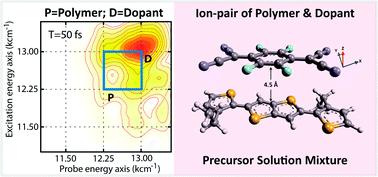当前位置:
X-MOL 学术
›
Chem. Sci.
›
论文详情
Our official English website, www.x-mol.net, welcomes your
feedback! (Note: you will need to create a separate account there.)
Origin of poor doping efficiency in solution processed organic semiconductors†
Chemical Science ( IF 7.6 ) Pub Date : 2018-04-10 00:00:00 , DOI: 10.1039/c8sc00758f Ajay Jha 1 , Hong-Guang Duan 1, 2, 3 , Vandana Tiwari 1, 4 , Michael Thorwart 2, 3 , R J Dwayne Miller 1, 3, 5
Chemical Science ( IF 7.6 ) Pub Date : 2018-04-10 00:00:00 , DOI: 10.1039/c8sc00758f Ajay Jha 1 , Hong-Guang Duan 1, 2, 3 , Vandana Tiwari 1, 4 , Michael Thorwart 2, 3 , R J Dwayne Miller 1, 3, 5
Affiliation

|
Doping is an extremely important process where intentional insertion of impurities in semiconductors controls their electronic properties. In organic semiconductors, one of the convenient, but inefficient, ways of doping is the spin casting of a precursor mixture of components in solution, followed by solvent evaporation. Active control over this process holds the key to significant improvements over current poor doping efficiencies. Yet, an optimized control can only come from a detailed understanding of electronic interactions responsible for the low doping efficiencies. Here, we use two-dimensional nonlinear optical spectroscopy to examine these interactions in the course of the doping process by probing the solution mixture of doped organic semiconductors. A dopant accepts an electron from the semiconductor and the two ions form a duplex of interacting charges known as ion-pair complexes. Well-resolved off-diagonal peaks in the two-dimensional spectra clearly demonstrate the electronic connectivity among the ions in solution. This electronic interaction represents a well resolved electrostatically bound state, as opposed to a random distribution of ions. We developed a theoretical model to recover the experimental data, which reveals an unexpectedly strong electronic coupling of ∼250 cm−1 with an intermolecular distance of ∼4.5 Å between ions in solution, which is approximately the expected distance in processed films. The fact that this relationship persists from solution to the processed film gives direct evidence that Coulomb interactions are retained from the precursor solution to the processed films. This memory effect renders the charge carriers equally bound also in the film and, hence, results in poor doping efficiencies. This new insight will help pave the way towards rational tailoring of the electronic interactions to improve doping efficiencies in processed organic semiconductor thin films.
中文翻译:

溶液处理有机半导体中掺杂效率差的原因†
掺杂是一个极其重要的过程,其中有意在半导体中插入杂质来控制其电子特性。在有机半导体中,一种方便但低效的掺杂方法是在溶液中旋转浇铸组分的前体混合物,然后蒸发溶剂。对此过程的主动控制是显着改善当前低掺杂效率的关键。然而,优化控制只能来自对导致低掺杂效率的电子相互作用的详细了解。在这里,我们使用二维非线性光谱通过探测掺杂有机半导体的溶液混合物来检查掺杂过程中的这些相互作用。掺杂剂接受来自半导体的电子,两个离子形成相互作用电荷的双链体,称为离子对复合物。二维光谱中分辨率良好的非对角峰清楚地表明了溶液中离子之间的电子连通性。这种电子相互作用代表了一种很好分辨的静电束缚态,而不是离子的随机分布。我们开发了一个理论模型来恢复实验数据,该模型揭示了一个出乎意料的强电子耦合,约为 250 cm-1,溶液中离子之间的分子间距离约为 4.5 Å,这大约是处理过的薄膜中的预期距离。这种关系从溶液持续到处理过的薄膜的事实直接证明了库仑相互作用从前体溶液到处理过的薄膜保留。这种记忆效应使电荷载流子也同样束缚在薄膜中,因此导致掺杂效率低下。这一新见解将有助于为合理调整电子相互作用铺平道路,以提高加工有机半导体薄膜的掺杂效率。
更新日期:2018-04-10
中文翻译:

溶液处理有机半导体中掺杂效率差的原因†
掺杂是一个极其重要的过程,其中有意在半导体中插入杂质来控制其电子特性。在有机半导体中,一种方便但低效的掺杂方法是在溶液中旋转浇铸组分的前体混合物,然后蒸发溶剂。对此过程的主动控制是显着改善当前低掺杂效率的关键。然而,优化控制只能来自对导致低掺杂效率的电子相互作用的详细了解。在这里,我们使用二维非线性光谱通过探测掺杂有机半导体的溶液混合物来检查掺杂过程中的这些相互作用。掺杂剂接受来自半导体的电子,两个离子形成相互作用电荷的双链体,称为离子对复合物。二维光谱中分辨率良好的非对角峰清楚地表明了溶液中离子之间的电子连通性。这种电子相互作用代表了一种很好分辨的静电束缚态,而不是离子的随机分布。我们开发了一个理论模型来恢复实验数据,该模型揭示了一个出乎意料的强电子耦合,约为 250 cm-1,溶液中离子之间的分子间距离约为 4.5 Å,这大约是处理过的薄膜中的预期距离。这种关系从溶液持续到处理过的薄膜的事实直接证明了库仑相互作用从前体溶液到处理过的薄膜保留。这种记忆效应使电荷载流子也同样束缚在薄膜中,因此导致掺杂效率低下。这一新见解将有助于为合理调整电子相互作用铺平道路,以提高加工有机半导体薄膜的掺杂效率。











































 京公网安备 11010802027423号
京公网安备 11010802027423号